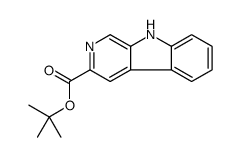tert-butyl beta-carboline-3-carboxylate

tert-butyl beta-carboline-3-carboxylate structure
|
Common Name | tert-butyl beta-carboline-3-carboxylate | ||
|---|---|---|---|---|
| CAS Number | 93835-05-3 | Molecular Weight | 268.31000 | |
| Density | 1.238g/cm3 | Boiling Point | 470ºC at 760mmHg | |
| Molecular Formula | C16H16N2O2 | Melting Point | N/A | |
| MSDS | USA | Flash Point | 238.1ºC | |
|
βCCT, an antagonist selective for α(1)GABA(A) receptors, reverses diazepam withdrawal-induced anxiety in rats.
Brain Res. Bull. 91 , 1-7, (2013) The abrupt discontinuation of prolonged benzodiazepine treatment elicits a withdrawal syndrome with increased anxiety as a major symptom. The neural mechanisms underlying benzodiazepine physical dependence are still insufficiently understood. Flumazenil, the ... |
|
|
Apparent pA2 values of benzodiazepine antagonists and partial agonists in monkeys.
J. Pharmacol. Exp. Ther. 290(3) , 1222-9, (1999) Drugs that bind to benzodiazepine recognition sites of gamma-aminobutyric acid type A receptor complexes may function as agonists in some behavioral assays and as antagonists in other behavioral assays. The present studies compared the effects of the benzodia... |
|
|
Cognition-impairing effects of benzodiazepine-type drugs: role of GABAA receptor subtypes in an executive function task in rhesus monkeys.
Pharmacol. Biochem. Behav. 104 , 62-8, (2013) The present studies evaluated the role of α1 and α5 subunit-containing GABAA receptors (α1GABAA and α5GABAA receptors, respectively) in the ability of benzodiazepine (BZ)-type drugs to alter performance in the cognitive domain of executive function. Five adul... |
|
|
Bidirectional effects of benzodiazepine binding site ligands on active avoidance acquisition and retention: differential antagonism by flumazenil and beta-CCt.
Psychopharmacology 180(3) , 455-65, (2005) The pharmacological approach, using subtype selective ligands, complements genetic studies on the specific contribution of individual receptor subtypes to the various effects of benzodiazepines.The aim of this study was to examine the relative significance of... |
|
|
The role of α1 and α5 subunit-containing GABAA receptors in motor impairment induced by benzodiazepines in rats.
Behav. Pharmacol. 23(2) , 191-7, (2012) Benzodiazepines negatively affect motor coordination and balance and produce myorelaxation. The aim of the present study was to examine the extent to which populations of γ-aminobutyric acid A (GABAA) receptors containing α1 and α5 subunits contribute to thes... |
|
|
Discriminative stimulus effects of L-838,417 (7-tert-butyl-3-(2,5-difluoro-phenyl)-6-(2-methyl-2H-[1,2,4]triazol-3-ylmethoxy)-[1,2,4]triazolo[4,3-b]pyridazine): role of GABA(A) receptor subtypes.
Neuropharmacology 58(2) , 357-64, (2010) Previous reports suggest that gamma-aminobutyric acid type A (GABA(A)) receptors containing alpha1 subunits may play a pivotal role in mediating the discriminative stimulus effects of benzodiazepines (BZs). L-838,417 (7-tert-Butyl-3-(2,5-difluoro-phenyl)-6-(2... |
|
|
Role of GABAA/benzodiazepine receptors containing alpha 1 and alpha 5 subunits in the discriminative stimulus effects of triazolam in squirrel monkeys.
Psychopharmacology 161(2) , 180-8, (2002) Conventional benzodiazepines (BZs), clinically used for treatment of anxiety and insomnia, bind to GABA(A) receptors containing alpha(1), alpha(2), alpha(3), or alpha(5) subunits. The role of these different GABA(A) receptor subtypes in mediating the subjecti... |
|
|
Influence of benzodiazepine binding site ligands on fear-conditioned contextual memory.
Eur. J. Pharmacol. 426(1-2) , 45-54, (2001) Eight compounds that bind to the benzodiazepine binding site on the gamma-amino butyric acid(A) (GABA(A)) receptor were assessed for their influence on contextual memory, an aspect of memory affected in various cognitive disorders including Alzheimer's diseas... |
|
|
Discriminative stimulus effects of benzodiazepine (BZ)(1) receptor-selective ligands in rhesus monkeys.
J. Pharmacol. Exp. Ther. 300(2) , 505-12, (2002) Drug discrimination was used to examine the effects of benzodiazepine (BZ)(1) receptor-selective ligands in rhesus monkeys. In diazepam-treated (5.6 mg/kg, p.o.) monkeys discriminating the nonselective BZ antagonist flumazenil (0.32 mg/kg, s.c.), the BZ(1)-se... |
|
|
Development of a two-step route to 3-PBC and βCCt, two agents active against alcohol self-administration in rodent and primate models.
J. Org. Chem. 76(11) , 4721-7, (2011) To gain access to 3-propoxy-β-carboline hydrochloride (3-PBC·HCl) (1·HCl) and β-carboline-3-carboxylate-tert-butyl ester (βCCt) (2), potential clinical agents active against alcohol self-administration, a two-step route was developed. This process involves a ... |